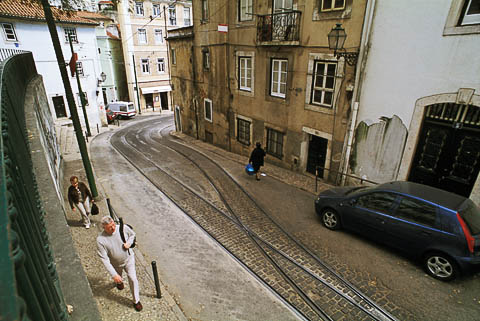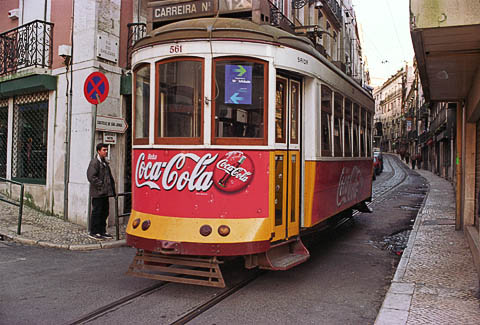  900mm gauge tram tacks in the old Alfama district of Lisbon 2004 J.Crawford We consider here why implementation of carfree areas in existing cities must be phased and should proceed at a moderate pace. We also consider measures to reduce car traffic early in the conversion process. Gradual ImplementationAlthough many workers and residents will prefer to walk or cycle to their destinations, almost any carfree conversion demands some form of public transport for a portion of travel within the city. Some people are unable to walk any great distance, or even to move by wheelchair without assistance. Some trips are inconveniently long to cycle, especially in larger cities. And some people, myself included, do not enjoy cycling when the temperature is below freezing. We need frequent, reliable, comfortable service. The means are well known and can be experienced anywhere in Switzerland.
 This narrow-gauge Lisbon tram runs through narrow streets, climbs steep hills, and negotiates very tight curves. Some cities will need this kind of flexibility in their public transport systems. 1998 J.Crawford If we accept the requirement for better public transport as a precondition for carfree conversions, then in most places we will have to wait while public transport is improved. This suggests that conversions should start at locations that are already relatively well served by bus or rail. In the early years, these areas will need car parking at the periphery. As public transport is improved, this need should disappear. The Latin American experience with Bus Rapid Transit [BRT] shows that these systems can be installed in just a few years. I believe BRT masterplans should include long-term plans to replace the buses with trams, as buses are uncomfortable, expensive, noisy, and smelly. In cases where streets are very narrow, small trams can pass where a full-sized bus cannot. This is seen in quite a few places in Lisbon. As an aside, I have for years advocated the development of wireless trams. This would enable new surface-running tram routes to be built as quickly as BRT. All that is necessary is to lay the rails. Almost all new trams are low-floor, so the high-level boarding platforms that BRT requires are not needed. Low-level platforms are quick and cheap to construct. They have the smallest possible impact on the street. At the turn of the last century, tram systems were installed in hundreds of cities nearly overnight. We could do it again, especially if we no longer had to string overhead wires. The aesthetic improvement is considerable, and the cost of maintaining the wires is eliminated. We will also need quick implementation of some zoning changes. An end to single-use zoning as practiced in the USA for the past 70 years is essential. Any use should be permitted at in any location as long as it does not interfere with residential life. This change would reverse the concentration of retailers into a few massive stores located far from where most people live. Families who wanted to open a small retail business in their homes would have a presumptive right to do it. Families should be permitted to move into areas that were once reserved only for offices or stores. In this manner, we can bring goods and services back within walking distance of the places people live and work. This greatly reduces the need for mobility and saves people time. The big-box stores will wither away. As discussed in the last issue, we should think in terms of rings of decreasingly strict limitations on vehicles as we move away from the central carfree areas. Not only will the diameters of these rings be increased over time, new carfree zones will be added as new public transport and cycling infrastructure are completed. It will be nearly impossible to keep trucks out of the carfree area until a rail-based freight delivery system is in place. Dedicated systems will be difficult to install in existing cities, but we can use trams for most freight delivery, a practice that is more than a century old and which is enjoying a small resurgence in Europe. In any case, trucks should be restricted to limited hours, a practice now common in Europe. Load consolidation should be enforced. This eliminates the many nearly-empty trucks entering the city and sends only fully-loaded trucks in their place. The governing principle is that an area can be made carfree as soon as good cycling infrastructure has been built, public transport is not farther than a five-minute walk away, and reasonable arrangements for freight delivery have been made. An important corollary is that the transport route system must permit reasonably easy, quick, and direct service to the important parts of the city. Transfers are the bane of rapid service. They cannot be avoided entirely, but an efficient route network and frequent service help to make them bearable. Incentives to Reduce Car TrafficOne trick that has already been quite widely employed is to make car travel so annoying that it is easier to walk, bike, or take public transport. Cities like Groningen in the Netherlands have divided the city center into several zones. Private cars may not move directly from one zone to the next. They must go all the way out of the city, around the ring road, and back in. Buses, however, move freely between the zones, as do cyclists. Car traffic in the city center is much reduced.In similar fashion, streets can be rearranged so that there are fewer direct routes for cars. Implementation can be as simple as just putting some bollards, tables, and chairs in the middle of a block. This closes the street to through traffic and gives back some important space to local residents without immediately eliminating too much on-street parking (which is likely to give rise to fierce resistance if proposed). A vital measure is the completion of the network of walking and cycling paths, so that direct routes are established to all destinations. In contemporary North American sprawl, destinations that are quite near by require long routes to reach them. This is no problem for car drivers but poses a real obstacle for pedestrians. A few simple paths can solve the problem. More than just these measures is required. I believe that financial disincentives to urban driving should be implemented. These can be put in place without waiting for better public transport, and can be used to pay for it. Externalized costs, such as air pollution and noise, should be monetized and paid by drivers. By some calculations, this will cause the price of fuel to increase by a factor of ten. These changes will considerably disrupt people's lives, so the first increases should be small, with the full charge being implemented over a span of several years. (It has not always been done this way: London's congestion charge in The City started at £5.00.) Parking fees should be increased immediately. Free parking should be eliminated, and all parking should be taxed. Again, rates should start rather low but planned and announced increases should encourage people to begin to change their transport behavior. Experience in Europe shows that people will leave their cars at home if there are strong disincentives to driving and reasonable alternatives. Other disincentives to driving are really incentives to use other modes. We must make the streets more beautiful, quieter, and more lively. We should encourage street food and street entertainment. As street space is reclaimed from cars, we must improve it. This labor-intensive work actually requires relatively little material. We want to remove parking meters, pavement markings, street signs, and the like. They can be replaced by planters, trees, benches and tables, convenient public toilets and drinking fountains, better light-duty pavement, and so forth. We need to fix the storm drains that trap bike wheels and fill the potholes that make riding rough. We will need more bike racks and more public-use bikes. We can reset traffic signals to give shorter greens for cars, which means that pedestrians and cyclists will not be so long delayed. This has the secondary effect of reducing the capacity for car traffic. Intersections should be narrowed and the turning radius sharpened, so cars have to slow down and pedestrians and cyclists have a safer crossing. We will need some car-sharing operations because travel to areas outside the city is not always possible by other modes. Experience has shown that car-sharing schemes encourage people to get rid of their own cars, which helps tremendously with parking. At the same time, the rather high fees for using a car discourage casual use. Finally, I will plead again for what I call the "drag-and-drop bike." This just takes the white-bike program one step farther. The bikes are free for anyone to use. There are no locks, no pin-passes, no electronic release. You just grab the nearest bike and shove it in a rack when you're done. I suppose that kids needing some pocket money will move the bikes to where they are needed and ask for some loose change in return. The bikes themselves can be quite cheap as long as they are simple, single-speed bikes. Pneumatic tires would be replaced by solid ones that never go flat. We will strive to make a delightful environment that encourages people to give up their cars and walk, bike, or take transit. As we do this, the quality of social life on the street will improve dramatically. People will notice the difference and support the ongoing change to a city with ever-fewer cars. One day the last one will be gone. First published in CarBusters #39 (Aug.-Oct. 2009).
|
Continue on to Fixing Transport
Back to Conversions Home
Return to Carfree.com Home
E-mail
carfree.com
2009 J.Crawford